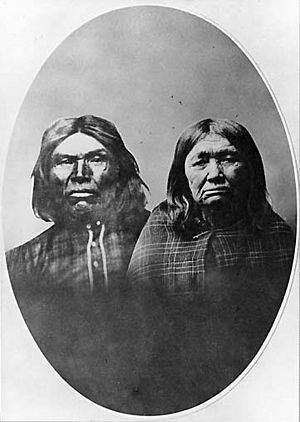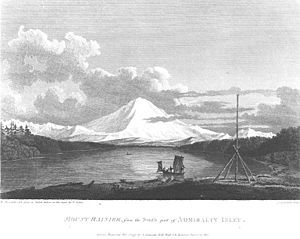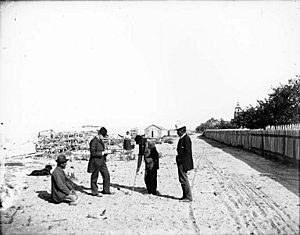Klallam facts for kids
|
Hicks family (Klallam) pose with canoe near Chimacum Creek, Washington, ca. 1914
|
|
| Regions with significant populations | |
|---|---|
| Languages | |
| Klallam, English | |
| Related ethnic groups | |
| other Coast Salish peoples |
The Klallam people are four related groups of Native Americans and First Nations from the Pacific Northwest region of North America. Their culture and language are part of the Coast Salish family.
Two Klallam groups live on the Olympic Peninsula in Washington state. One group is on the Kitsap Peninsula in Washington. Another group is based at Becher Bay on southern Vancouver Island in British Columbia, Canada.
Contents
Klallam: What's in a Name?
The Klallam people call themselves nəxʷsƛ̕ay̕əm, which means "strong people." The word "Klallam" comes from another language, North Straits Salish language, and has been spelled many ways over time.
In 1854, when Clallam County was created, the spelling "Clallam" was used. A year later, the Point No Point Treaty used "S'klallam." Today, the spelling "Clallam" often refers to people from Clallam County, both native and non-native. However, the spelling with 'K' (Klallam) is usually used for the native people themselves.
For example, the Lower Elwha tribe uses "Klallam" as its official spelling. The Port Gamble and Jamestown tribes use "S'Klallam."
Klallam History
Life Before European Contact
Before Europeans arrived, the Klallam people lived along the northern coast of the Olympic Peninsula. Their land stretched from the Hoko River in the west to Port Discovery Bay in the east. Some Klallam also lived on Vancouver Island in Canada.
Most Klallam villages were along the coast. Some were inland, near rivers or lakes. The Klallam people were united by their language and traditions. They also traded and married people from nearby tribes.
Like many other native groups in the Pacific Northwest, the Klallam held special ceremonies called potlatches. These events were important for showing a family's wealth and social standing.
First European Encounters
European explorers first reached the Pacific Northwest coast in the late 1700s. The Klallam people heard about these newcomers even before they met them.
The first European known to enter the Strait of Juan de Fuca was Charles William Barkley in 1787. Robert Gray reached Clallam Bay in 1789. Spanish explorers also visited the area between 1790 and 1792. It's not clear which ship first met the Klallam, but it was likely before 1789. They traded items like knives and copper.
In 1792, George Vancouver met the Klallam. He was surprised that they seemed uninterested in his visit. He traded copper and knives with them.
Changes After Contact
In 1825, the Hudson's Bay Company (HBC) set up Fort Vancouver on the Columbia River. There wasn't much contact between the Klallam and the fort at first. In 1828, a conflict happened when five white men were killed by some Klallam. In response, about 60 men from Fort Vancouver attacked a Klallam group, killing seven people and burning their homes. They also attacked and destroyed a Klallam village near Dungeness Spit, killing about 25 Klallam in total.
Later, in 1832, the HBC opened Fort Nisqually on Puget Sound. Klallam people began visiting the fort to trade furs and game. They often wanted better prices for their goods.
In 1847, an artist named Paul Kane visited the region. He noted that the Klallam still practiced slavery and used guns instead of bows and arrows. He also saw that duck netting was common and that shell money was still valuable.
Conflicts and New Settlements
In 1847, about 150 Klallam warriors joined with the Suquamish tribe, led by Chief Seattle. They attacked the Chimakum people, almost wiping them out. The few Chimakum who survived fled. After this, the Klallam moved into the former Chimakum territory.
White settlers began arriving in the area in the early 1850s. Sawmills started operating in places like Port Townsend and Port Gamble. A small settlement was also built near Dungeness Spit, close to what is now Sequim.
In 1855, an expert named George Gibbs visited the Klallam. He estimated their population was 926, which was lower than before, mostly due to diseases brought by Europeans. He noted that the Klallam had many European tools and were growing potatoes. The fur trade was no longer as important.
The Point No Point Treaty
In 1855, the Klallam, along with other tribes, signed the Point No Point Treaty. This treaty meant the Klallam were supposed to give up their land and move to the Skokomish Reservation. In return, they would receive government help and supplies. However, the Klallam never moved. They stayed in their traditional lands along the northern Olympic Peninsula.
Challenges and Resilience
Clallam County was created in 1854, but it remained small for many years. Around 1860, there was a smallpox outbreak among the Klallam.
The last intertribal war involving the Klallam happened in 1869. A group of Klallam men attacked and killed over thirty Tsimshian people on Dungeness Spit. This was revenge for the Tsimshian taking some Klallam women years earlier.
After 1862, the Klallam population dropped more quickly, from about 1,300 to 597 by 1878. By 1870, most Klallam lived near Dungeness Spit and Sequim. White settlers in Dungeness tried to force the Klallam to move.
The Birth of Jamestown
Facing pressure, Klallam Chief James Balch led his people to buy their own land. In 1874, he and other leaders collected enough money to buy 250 acres. They founded a town they named Jamestown, after Chief James Balch. This was very unusual because Native people were not legally allowed to buy land at that time. By doing this, they gave up the chance for federal government help. For many years, Jamestown was one of the few Native settlements fully owned and managed by Native people themselves.
More than a century later, in 1981, the Jamestown S'Klallam Tribe of Washington officially gained federal recognition after six years of effort. Today, there are several other Klallam groups, including the Lower Elwha Klallam Tribe, the Port Gamble Band of S'Klallam Indians, and the Scia'new First Nation in Canada.
Klallam Culture
Travel and Transportation
The land on the Olympic Peninsula was rugged and covered in thick plants. Because of this, the canoe was the best way to travel. Klallam canoes were carved from western red cedar trees. This was a difficult process that needed great skill. The knowledge of how to make canoes was passed down through generations. Sometimes, larger canoes were bought from other tribes.
The Klallam used two main types of canoes:
- Smaller Coast Salish canoes: These were used on calm waters for fishing or carrying small loads. They were usually 12 to 30 feet long.
- Larger Chinook style canoes: These were used on rougher waters like Puget Sound and the Strait of Juan de Fuca. They could be over 30 feet long and carry up to thirty people. These were also used for whaling.
Early white settlers were impressed by how skilled the Klallam were at handling and navigating their canoes.
Traditional Diet
The Klallam people had plenty of food all year round from their lands, rivers, and coastal waters. They also had agreements with other tribes to hunt or gather food outside their main territory.
Their diet included land animals, sea birds, and shellfish. However, fish was the most important food source. Salmon still plays a big role in Klallam culture, both for food and for spiritual reasons.
The Klallam fished all year using different tools and methods depending on the type of fish, where they were fishing, and the season. They used traps, trolling, gillnets, spears, rakes, dip nets, and holes dug in the beach. They knew exactly where and when to find certain fish.
Traditional Plant Use
The Klallam people used plants for many purposes. For example, they would crush the flowers of the Viola adunca plant and apply them to the chest or side to help with pain.
Klallam Tribal Groups
- Lower Elwha Tribal Community of the Lower Elwha Reservation, Washington
- Jamestown S'Klallam Tribe of Washington
- Port Gamble Indian Community of the Port Gamble Reservation, Washington
- Scia'new First Nation (Becher Bay Indian Band), Vancouver Island, British Columbia
Klallam Schools
The Klallam tribes do not run their own schools. However, they work to keep their language and culture alive in local schools.
- Children from the Lower Elwha Klallam Tribe can join a Klallam cultural and language program at the Lower Elwha Klallam Head Start. Older children learn the Klallam language and tribal history at Dry Creek Elementary, Stevens Middle School, and Port Angeles High School.
- Most children from the Jamestown S'Klallam Tribe attend schools in the Sequim School District.
- Most children from the Port Gamble Klallam Tribe attend schools in the North Kitsap School District in the Kingston area.
See also
 In Spanish: Klallam para niños
In Spanish: Klallam para niños





